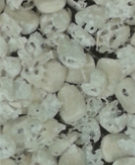Larger Grain Borer
 Prostephanus truncatus, the larger grain borer.
Prostephanus truncatus, the larger grain borer.
Prostephanus truncatus, the larger grain borer – more commonly known as LGB, or colloquially referred to as Dumuzi, Osama or Scania amongst other names – is a serious insect pest of stored maize and dried cassava.
It has been found to cause double the storage losses than other common insect pests such as the maize weevil, Sitophilus zeamais. The pest can also survive and breed in forest habitats and timber.
The maize storage loss figure is multiplied by 2 in the APHLIS algorithm to reflect the impact of this insect's presence on maize storage losses.
Due to the severity of the damage caused by the pest, which can turn maize to dust, if it is present at significant levels in a particular location in that season, the maize storage loss figure is multiplied by 2 in the APHLIS algorithm to reflect the impact of this insect's presence on maize storage losses. This is based on several research studies which found in the presence of this pest weight losses of maize doubled from about 5% to about 10%.
 Maize grain damaged by the larger grain borer.
Maize grain damaged by the larger grain borer.
History and distribution of LGB in Africa
This small beetle was accidentally introduced to both Tanzania and Togo from its native central America at the end of the 1970’s, and has now spread to many other African countries: Kenya, Uganda, Ethiopia, Somalia, Rwanda, Burundi, Senegal, Guinea-Bissau, Burkina Faso, Ghana, Benin, Niger, Nigeria, Cameroon, Guinea, Namibia, South Africa, Zimbabwe, Zambia, Mozambique, Malawi, Eswatini; see global distribution map in Muatinte et al., 2019.
Protecting maize grain against LGB attack
Treatment recommendations to protect stored grain against this pest include shelling the maize and mixing the shelled grain with an effective insecticide dust at the recommended application rate before storing it in sacks. Storage of untreated maize grain in hermetic containers (hermetic drums, silos, bags etc.) can also be effective, but if hermetic bags are used this pest sometimes bores through the plastic leading to high damage levels of the stored grain and bag. A recent review by Quellhorst et al., 2021 synthesises and compares the data from studies of different management practices used to control LGB.
References
Boxall, R.A., 2002. Damage and loss caused by the Larger Grain Borer Prostephanus truncatus. Integrated Pest Management Reviews, 7: 105-121.
Dick, K., 1989. A review of insect infestation of maize in farm storage in Africa with special reference to the ecology and control of Prostephanus truncatus. Overseas Development Natural Resources Institute, Chatham, UK: Bulletin 18, pp. 42.
Dunstan, W.R. & Magazini, I. 1980. Outbreaks and new records. Tanzania. The larger grain borer on stored products. FAO Plant Protection Bulletin. 29:80–81.
Golob, P., 2002. Chemical, physical and cultural control of Prostephanus truncatus. Integrated Pest Management Reviews, 7: 245-277.
Hodges, R.J., Dunstan, W.R., Magazini, I., Golob, P. 1983. An outbreak of Prostephanus truncatus (Horn) (Coleoptera: Bostrichidae) in East Africa. Prot. Ecol. 5, 1983-94.
Nang’ayo, F.L.O., Hill, M.G., Chandi, E.A., Nzeve, N.V. and Obiero, J. 1993. The natural environment as a reservoir for the larger grain borer Prostephanus truncatus (Horn) (Coleoptera: Bostrichidae) in Kenya. African Crop Science Journal, 1(1): 39–47.
Muatinte, B.M., Boukouvala, M., Garcia-Lara, S., Lopez-Castillo, L.M., 2019. The threat of the larger grain borer, Prostephanus truncatus (Coleoptera: Bostrichidae) and practical control options for the pest. CAB Reviews Perspectives in Agriculture Veterinary Science Nutrition and Natural Resources, 14(041): 1-25.
Makundi, R.H., Swila, N.N., Misangu, R.N., Reuben, S.W.M., Mwatawala, M., Sikira, A., Kilonzo, B.S., Lyimo, H., et al. 2010. Dynamics of infestation and losses of stored maize due to the larger grain borer (Prostephanus truncatus Horn) and maize weevils (Sitophilus zeamais Motschulsky). Archives of Phytopathology and Plant Protection, 43(14):1346–1355. https://doi.org/10.1080/03235400802425804
Mlambo, S., Mvumi, B.M., Stathers, T., Mubayiwa, M. & Nyabako, T. 2017. Field efficacy of hermetic and other maize grain storage options under smallholder farmer management. Crop Protection, 98: 198–210. https://doi.org/10.1016/j.cropro.2017.04.001
Mlambo, S., Mvumi, B.M., Stathers, T., Mubayiwa, M. & Nyabako, T. 2018. Field efficacy and persistence of synthetic pesticidal dusts on stored maize grain under contrasting agro-climatic conditions. Journal of Stored Products Research, 76: 129-139. https://doi.org/10.1016/j.jspr.2018.01.009
Quellhorst, H., Athanassiou, C.G., Zhu, K.Y., Morrison III, W.R. 2021. The biology, ecology and management of the larger grain borer, Prostephanus truncatus (Horn) (Coleoptera: Bostrichidae). Journal of Stored Products Research, 94, 101860. https://doi.org/10.1016/j.jspr.2021.101860